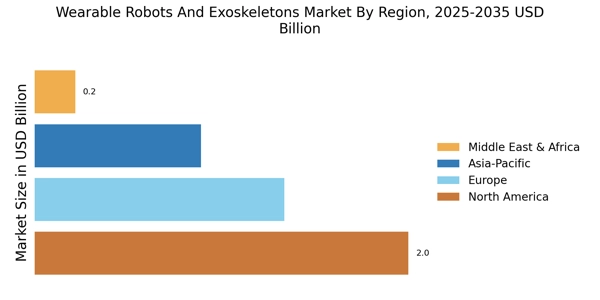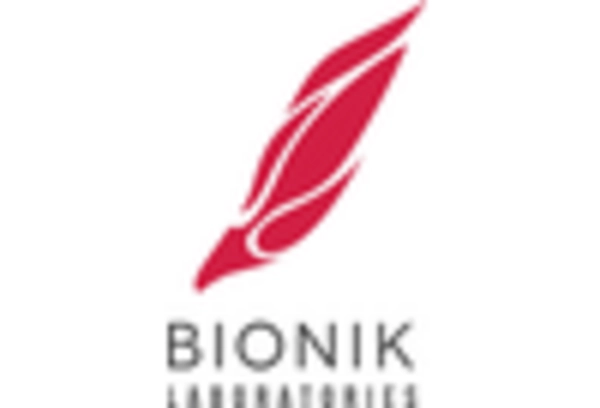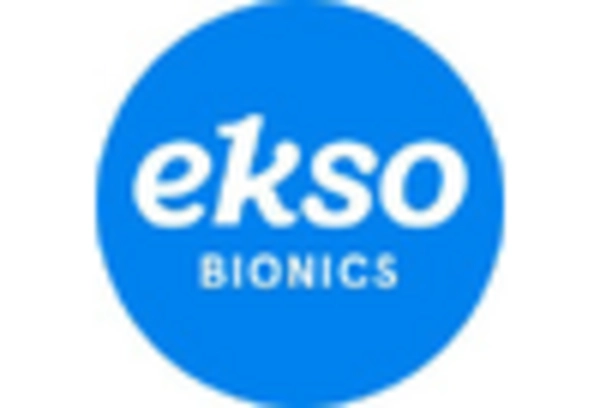The Wearable Robots and Exoskeletons Market is currently characterized by a dynamic competitive landscape, driven by technological advancements and increasing demand for rehabilitation solutions. Key players such as Ekso Bionics (US), ReWalk Robotics (IL), and Cyberdyne (JP) are at the forefront, each adopting distinct strategies to enhance their market positioning. Ekso Bionics (US) focuses on innovation in exoskeleton technology, particularly in the medical sector, while ReWalk Robotics (IL) emphasizes partnerships with healthcare providers to expand its reach. Cyberdyne (JP) is leveraging its expertise in robotics to penetrate various sectors, including industrial applications, thereby diversifying its operational focus. Collectively, these strategies contribute to a competitive environment that is increasingly centered on technological differentiation and strategic collaborations.
In terms of business tactics, companies are localizing manufacturing and optimizing supply chains to enhance efficiency and reduce costs. The market structure appears moderately fragmented, with several players vying for market share. However, the influence of key players is substantial, as they set benchmarks for innovation and operational excellence. This competitive structure fosters an environment where emerging companies must innovate rapidly to keep pace with established leaders.
In August 2025, Ekso Bionics (US) announced a partnership with a leading rehabilitation hospital to integrate its exoskeleton technology into patient recovery programs. This strategic move is likely to enhance the company's visibility in the healthcare sector and solidify its reputation as a leader in rehabilitation technology. By collaborating with healthcare providers, Ekso Bionics (US) not only expands its market reach but also gains valuable insights into patient needs, which could inform future product development.
In September 2025, ReWalk Robotics (IL) launched a new version of its exoskeleton designed specifically for home use, aiming to improve the quality of life for individuals with mobility impairments. This product launch signifies a strategic shift towards consumer-oriented solutions, potentially opening new revenue streams. By addressing the needs of end-users directly, ReWalk Robotics (IL) positions itself as a pioneer in the personal mobility sector, which may enhance its competitive edge.
In July 2025, Cyberdyne (JP) secured a contract with a major automotive manufacturer to develop exoskeletons for factory workers, aimed at reducing workplace injuries. This collaboration underscores Cyberdyne's strategic focus on industrial applications, which could lead to significant market expansion. By diversifying its offerings beyond healthcare, Cyberdyne (JP) is likely to tap into a lucrative segment of the market, thereby enhancing its growth prospects.
As of October 2025, the competitive trends in the Wearable Robots and Exoskeletons Market are increasingly defined by digitalization, sustainability, and the integration of artificial intelligence. Strategic alliances are becoming more prevalent, as companies recognize the value of collaboration in driving innovation. Looking ahead, competitive differentiation is expected to evolve, with a shift from price-based competition to a focus on technological innovation, supply chain reliability, and sustainable practices. This transition may redefine market dynamics, compelling companies to invest in R&D and strategic partnerships to maintain their competitive advantage.


















Leave a Comment